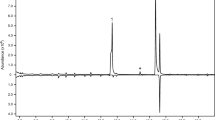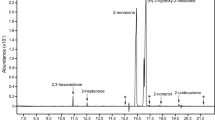Abstract
A male-produced aggregation pheromone was demonstrated inCarpophilus hemipterus (L.) (Coleoptera: Nitidulidae) using a wind-tunnel bioassay. Both sexes responded to the pheromone, but the beetles flew in the wind tunnel only after they had been starved for at least several hours. The attractiveness of the pheromone was greatly enhanced by volatiles from a food source, and combinations of pheromone and food volatiles typically attracted 3–10 times more beetles than either source by itself. A variety of food-related sources of volatiles were effective. These included apple juice; a mixture of baker's yeast plus banana; the pinto bean diet used for rearing this beetle; the chemicals propyl acetate, ethanol; and a mixture of acetaldehyde, ethyl acetate, and ethanol. The pheromonal activity resided with a series of 10 male-specific, unsaturated hydrocarbons of 13, 14, and 15 carbon atoms. These were partially separated by HPLC. No single compound was absolutely required for pheromonal activity to be observed, and various subsets of these compounds were active. The most abundant component was (2E,4E,6E,8E)-3,5,7-trimethyl-2,4,6,8-decatetraene. One minor component was (2E,4E,6E,8E)-3,5,7-trimethyl-2,4,6,8-undecatetraene. These structures were proven by synthesis. Together, the synthetic compounds were as active in the wind tunnel as the beetle-derived pheromone.
Similar content being viewed by others
References
Alm, S.R., Hall, F.R., Ladd, T.L, Jr., andWilliams, R.N. 1985. A chemical attractant forGlischrochilus quadrisignatus (Coleoptera: Nitidulidae).J. Econ. Entomol. 78:839–843.
Alm, S.R., Hall, F.R., McGovern, T.P., andWilliams, R.N. 1986. Attraction ofGlischrochilus quadrisignatus (Coleoptera: Nitidulidae) to semiochemicals: Butyl acetate and propyl propionate.J. Econ. Entomol. 79:654–658.
Anet, F.A.L., andBourn, A.J.R. 1965. Nuclear magnetic resonance spectral assignments from nuclear Overhauser effects.J. Am. Chem. Soc. 87:5250–5251.
Baker, T.C., andLinn, C.E., Jr. 1984. Wind tunnels in pheromone research, pp. 75–110,in H.E. Hummel and T.A. Miller (eds.). Techniques in Pheromone Research. Springer-Verlag, New York.
Bartelt, R.J., Schaner, A.M., andJackson, L.L.1986. Aggregation pheromones in five taxa of theDrosophila virilis species group.Physiol. Entomol. 11:367–376.
Birch, M.C.1984. Aggregation in bark beetles, pp. 331–353,in W.J. Bell and R.T. Cardé (eds.). Chemical Ecology of Insects. Sinauer Associates, Sunderland, Massachusetts.
Boland, W., Jaenicke, L., Muller, D.G., andGassmann, G. 1987. Giffordene, 2Z,4Z,6E,8Z- undecatetraene, is the odoriferous principle of the marine brown algaGiffordia mitchellae.Experientia 43:466–467.
Boutaoy, J., andThomas, R. 1974. Olefin synthesis with organic phosphonate carbanions.Chem. Rev. 74:87–99.
Brooks, L.A., andSnyder, H.R. 1955. 3-Penten-2-ol.Org. Synth. Coll. Vol. 3:696–698.
Brownlee, R.G., andSilverstein, R.M.1968. A micropreparative gas chromatograph and a modified carbon skeleton determinator.Anal. Chem. 40:2077–2079.
Cardé, R.T. 1984. Chemo-orientation in flying insects, pp. 111–124,in W.J. Bell and R.T. Cardé (eds.). Chemical Ecology of Insects. Sinauer Associates, Sunderland, Massachusetts.
Dess, D.B., andMartin, J.C. 1983. Readily accessible 12-1-5 oxidant for the conversion of primary and secondary alcohols to aldehydes and ketones.J. Org. Chem. 48:4155–4156.
Dowd, P.F. 1987. A labor saving method for rearing the driedfruit beetle (Coleoptera: Nitidulidae) on pinto bean-based diet.J. Econ. Entomol. 80:1351–1353.
Gallagher, G., Jr., andWebb, R.L. 1974. Tetrasubstituted acrylates: The Wittig-Horner reaction of ketones with triethyl 2-phosphonopropionate.Synthesis 1974:122–124.
Heath, R.R., andSonnet, P.E. 1980. Technique for in situ coating of Ag+ onto silica gel in HPLC columns for the separation of geometrical isomers.J. Liq. Chromatogr. 3:1129–1135.
Hinton, H.E. 1945. A Monograph of the Beetles Associated with Stored Products. Jarrold and Sons, Norwich, U.K. 443 pp.
Huisgen, R., Dahmen, A., andHuber, H. 1967. Stereospecific conrotatory valence isomerization of octatetraenes to cycloocta-1,3,5-trienes.J. Am. Chem. Soc. 89:7130–7131.
Mori, K. 1976. Synthesis of optically active forms of ipsenol, the pheromone ofIps bark beetles.Tetrahedron 32:1101–1106.
Näf, F., Decorzant, R., Thommen, W., Willhalm, B., andOhloff, G. 1975. 110. The four isomeric 1,3,5-undecatrienes: Synthesis and configurational assignment.Helv. Chim. Acta 58:1016–1037.
Nelson, D.R. 1978. Long-chain methyl-branched hydrocarbons: occurrence, biosynthesis and function.Adv. Insect Physiol. 13:1–33.
Noller, C.R., andDinsmore, R. 1943. Isobutyl bromide.Org. Synth., Coll. Vol. 2:358–360.
Oehlschlager, A.C., Pierce, A.M., Pierce, H.D., Jr., andBorden, J.H. 1988. Chemical communication in cucujid grain beetles.J. Chem. Ecol. 14:2071–2098.
Parliment, T.H. 1973. Convenient technique for microhydrogenation.Microchem. J. 18:613–616.
Patel, P., andPattenden, G. 1985. Natural polyene α-pyrones: Total synthesis of citreomontanin fromPenicillium pedomontanum.Tetrahedron Lett. 26:4789–4792.
Phillips, J.K., andBurkholder, W.E. 1981. Evidence for a male-produced aggregation pheromone in the rice weevil.J. Econ. Entomol. 74:539–542.
Poole, C.F., andSchuette, S.A. 1984. Contemporary Practice of Chromatography. Elsevier, Amsterdam. 708 pp.
Sanders, J.K.M., andMersh, J.D. 1982. Nuclear magnetic double resonance; the use of difference spectroscopy.Prog. NMR Spectrosc. 15:353–400.
Silverstein, R.M., andBassler, G.C. 1967. Spectrometric Identification of Organic Compounds. John Wiley & Sons, New York. 256 pp.
Smilanick, J.M., Ehler, L.E., andBirch, M.C. 1978. Attraction ofCarpophilus sp. to volatile compounds of figs.J. Chem. Ecol. 4:700–701.
Sonnet, P.E. 1974.cis-Olefins from the Wittig reaction.Org. Prep. Proc. Int. 6:269–273.
Waloenbach, C.A., Burkholder, W.E., Curtis, M.J., andKhan, Z.A. 1987. Laboratory trapping studies withSitophilus zeamais (Coleoptera: Curculionidae).J. Econ. Entomol. 80:763–767.
Wicklow, D.T., 1989. Maize cultivation selects for mycotoxin-producing ability among kernalrotting fungi, pp. 263–274,in C.H. Chou and G.R. Waller (eds.). Phytochemical Ecology: Allelochemicals, Mycotoxins, and Insect Pheromones and Allomones. Institute of Botany, Academia Sinica Monograph Series No. 9, Taipei, Republic of China.
Yates, F. 1940. The recovery of interblock information in balanced incomplete block designs.Ann. Eugen. 10:317–325.
Author information
Authors and Affiliations
Rights and permissions
About this article
Cite this article
Bartelt, R.J., Dowd, P.F., Plattner, R.D. et al. Aggregation pheromone of driedfruit beetle,Carpophilus hemipterus Wind-tunnel bioassay and identification of two novel tetraene hydrocarbons. J Chem Ecol 16, 1015–1039 (1990). https://doi.org/10.1007/BF01021008
Received:
Accepted:
Issue Date:
DOI: https://doi.org/10.1007/BF01021008




